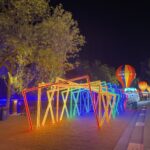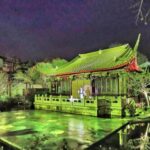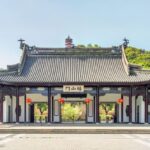Xiyuan Temple, known by many names, can be found on Baidu or Google Maps under various designations such as Jiesi Law Temple, Xiyuan Ancient Temple, and Xiyuan, all referring to the same location. The temple was originally constructed during the Yuan Dynasty’s Zhiyuan era (A.D. 1264-1294), initially named Guiyuan Temple, with the existing structures rebuilt during the Qing Dynasty. During the Ming Dynasty’s Jiajing years, it was temporarily transformed into a private garden by Xu Taishi, the creator of the Lingering Garden and a high-ranking official.
Today, the temple serves as a temple garden within Suzhou city, and its combination of temple and garden architecture is likely influenced by the Ming era. The main temple buildings are aligned along a north-south central axis, allowing visitors to tour them sequentially.South of the temple is a screen wall inscribed with ‘Jiesi Law Temple.’ North of the screen wall, the福德 Bridge and the Wisdom Bridge span across the Shang Tang River side by side. On the opposite bank stands an imperial plaque inscribed with ‘Imperially Bestowed Xiyuan Jiesi Law Temple,’ with the vertical plaque at the top center reading ‘Zhen Guo Jie Zhuang,’ a title bestowed by Emperor Guangxu of the Qing Dynasty. North of the imperial plaque is the temple’s main gate. Upon entering, one is greeted by a large square filled with pine and cypress trees. Xiyuan Temple boasts many ancient trees, including camphor and ginkgo trees that are over a century old.

Proceeding north along the path, the east and west sides feature a bell tower and a drum tower, respectively. Beyond the path lies the Mahavira Hall. The northernmost building, the Sanbao Tower, serves as the scripture repository and is not open to the public. To the east of the Mahavira Hall is the Guanyin Hall, while the Hall of Five Hundred Arhats to the west is a must-see structure within the temple.

South of the arhat hall stands a statue of Ji Gong, and to the north, a statue of a mad monk. Both statues are remarkably lifelike, with their clothing and folds appearing almost real. It is said that they were created as a competition between the two lead sculptors who also made the five hundred arhat statues. Moving further west, the western part of the temple, known as Xiyuan, is another highlight.

Regrettably, one of the turtles passed away in 2007. A bronze statue of the turtle is placed at the southwest corner of the Release Pond, allowing visitors who cannot see the real turtle to take a photo with the statue to compensate for the regret.
On the east side of the Release Pond is the ‘All-Sided Hall’, which serves as a place for Buddhist merchandise circulation, where one can purchase Buddhist prayer beads and other religious souvenirs. On the terrace of the All-Sided Hall, there are two wisteria trees from the Ming Dynasty, over 400 years old, and a wisteria tree that is more than 500 years old on the south side. The Dharma Propagation Department to the south of Xiyuan offers free Buddhist scriptures. Xiyuan Temple is known among local people in Suzhou as a temple where wishes come true, making it an ideal place for praying. On the first and fifteenth day of the lunar month, the temple is always filled with worshippers; during the Spring Festival, the incense burners are particularly busy, with many worshippers rushing to offer incense on the first day of the lunar new year. On the birthdays and anniversaries of various Bodhisattvas, the temple also holds Dharma assemblies. Inside the temple, there is a vegetarian restaurant located to the west of the Hall of the Heavenly Kings and to the south of the Hall of Five Hundred Arhats. There are only three types of noodles available: Ruyi noodles, Arhat vegetarian noodles, and Guanyin noodles, with an average cost of only 10 yuan per person. Outside the temple, there is a meritorious forest, an ancient vegetarian restaurant, with prices slightly higher than those inside the temple. The vegetarian chicken and ‘sweet and sour pork ribs’ are particularly delicious. To the west of Xiyuan Temple is Hanshan Temple, to the east is Lingering Garden, and to the north are Ding Garden and Tiger Hill. Visitors can arrange their sightseeing routes according to their preferences. The temple is open all year round from 07:30 to 18:00. Preferential Policy: Children under 6 years old (inclusive of 6 years) or under 1.4 meters (inclusive of 1.4 meters) in height with valid identification are admitted free of charge. Free admission for children, students, and the elderly: minors from 6 years (not including 6 years) to 18 years (inclusive of 18 years), full-time undergraduate and below students, and elderly people from 60 years (inclusive of 60 years) to 70 years (not including 70 years) with valid identification are eligible for half-price tickets (discount tickets should be purchased at the scenic spot). Elderly people aged 70 years (inclusive of 70 years) and above with valid identification are admitted free of charge. Free admission for military personnel: active servicemen and retired military officers of the People’s Republic of China with valid identification are admitted free of charge. Free admission for disabled persons: disabled individuals and one accompanying person for severely disabled individuals with valid identification are admitted free of charge. Additional Information: The above information is for reference only; specific details are subject to the public notice at the scenic spot.








